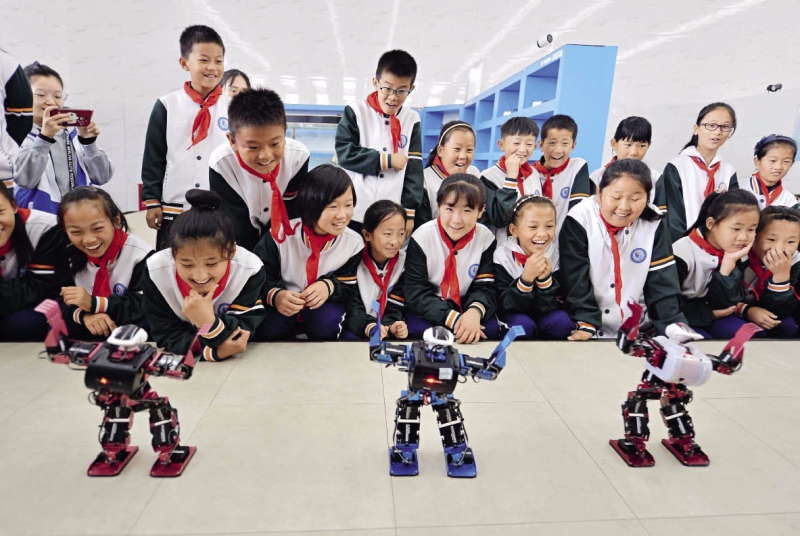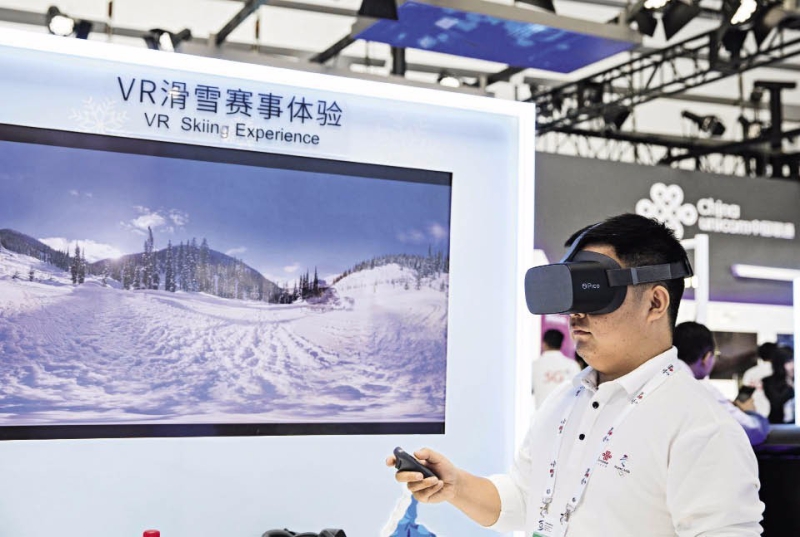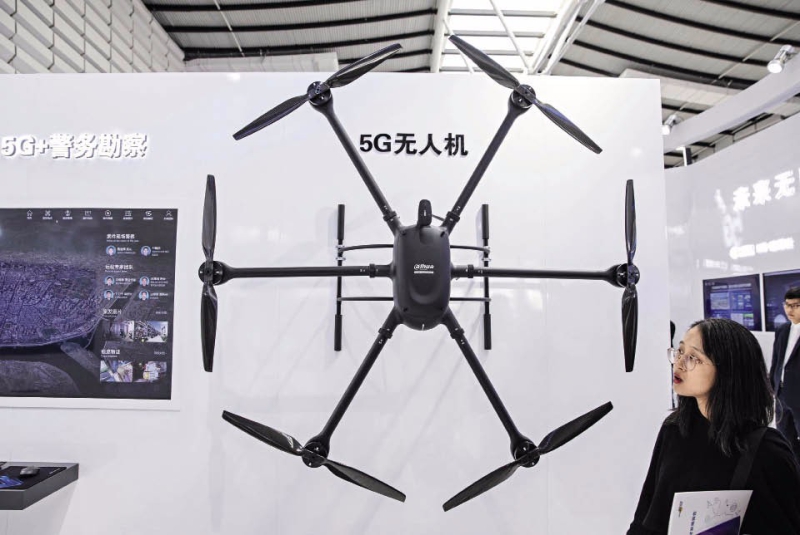The “Light of Internet” Expo held on October 18, 2019 in Wuzhen of Zhejiang Province brings an innovative experience of 5G techno-logy to visitors.

The “Light of Internet” Expo held on October 18, 2019 in Wuzhen of Zhejiang Province brings an innovative experience of 5G techno-logy to visitors.
In a speech delivered at the 2019 World 5G Convention held in Beijing on November 20, 2019, Lei Jun, founder and chairman of Xiaomi Corp., said, “5G, the fifth generation wireless networks, will facilitate the provision of an omnipresent and affordable broadband with low-latency, high-speed connectivity, and thus improve the user’s experience in smart home, 4K/8K HD video, and VR/AR.”
Lei said cellphones plus the Artificial Intelligence of Things (AIoT) will be the core strategy of Xiaomi in the next five years in tandem with the upcoming super network “5G+AI+IoT,” the wireless networks combined with technologies of 5G, Artificial Intelligence (AI), and Internet of Things (IoT).
“In 2020, Xiaomi will unveil at least 10 models of 5G mobile phones,” said Lei.

On October 21, 2019, students visit the International Robot Center in Qingdao, Shandong Province, and are attracted by the performance of a team of tiny robots.
Big Business
On last year’s Double Eleven Day (November 11) in China, the online and offline sales volume of Xiaomi smart home products surpassed 5.55 million, a year-on-year growth of 148 percent; whilst televisions, laptops, air-cleaners, and smart speakers, as well as other products, altogether 219 went straight to number one on the best-seller list. All these products can be automatically connected via a Xiaomi smartphone in the era of 5G.
“The 5G cellphone age is coming, which will bring massive profits to the manufacturers,” said Lei, who also announced that the newly built Xiaomi Future Factory — a R&D smart manufacturing facility of Xiaomi’s flagship smartphones with a phase-one design capacity of one million units in Yizhuang, Beijing’s only state-level economic development zone.
Automatic assembly lines, 5G wireless networks, industrial robots, and big data technology used in large scale production will enable the factory to produce around 60 smartphones a minute, 60 percent faster than traditional production.
“Fueled by advanced technology and customer demands, 5G will usher in a new era of intelligent IoT, underpinning economic and social changes and transformation of traditional industries,” said Yang Tao, vice president of Huawei’s China Carrier Business Department. He said 5G, cloud computing, and AI are three pillars of the digital economy.

On October 18, 2019, a visitor wears the 5G VR glasses to experience skiing in Wuzhen.
Disruptive Life Changes
Not only will homes and entertainment be changed by 5G, numerous areas including smart cities, telemedicine, and driverless cars are supported by this new technology.
On March 16, 2019, in Sanya City, Hainan Province, Ling Zhipei, chief physician of the Neurosurgery Department of The PLA General Hospital, succeeded in implanting a brain pacemaker into a Parkinson’s patient 3,000 kilometers away in Beijing. This was achieved with the aid of the 5G network established by Huawei and China Mobile.
Ling manipulated the device via remote control of the medical software on computer, detected real-time brain wave signals, and then confirmed the accurate position to insert the pacemaker within a six millimeter space. What takes 300 milliseconds latency under the 4G network takes only 30 milliseconds using 5G technology.
Within two hours, the brain pacemaker was successfully implanted. Ten days later, the patient, who had been ill for five years, could walk as a healthy person.
Most patients in need of a brain pacemaker are not mobile. The long journey to the hospital is not only inconvenient, but also high-risk and high-cost, the telemedicine gives patients an effective treatment option.
“In an aging society, caring for the elderly and geriatrics have become important issues. The application of 5G technology in medical treatment gives people all over the country access to quality medical resources,” said Yang Tao.

5G camera drones displayed at the “Light of Internet” Expo can be easily controlled by a remote to complete all possible missions.
Smarter and Safer
In the era of 5G, driverless vehicles will become commonplace. At the convention’s Tencent exhibition center, a pilotless car’s steering wheel revolved automatically, as it interacted with a big screen showing real-time traffic. The set provides a simulation system integrating technologies such as big data, cloud platforms, and deep learning. Using 5G technology, this car can learn traffic patterns and test drive safely.
So how is the security of smart driving ensured? For example, a hacker can take remote control of the car’s steering wheel, lights and doors using just a regular tablet. When our cellphones and emails are hacked, only the disclosure of information occurs; but a driverless car out of control would put our lives in danger.
Therefore, a real-time defensive “vehicle safety brain” is crucial. A Tencent engineer explained that hacker’s attacks need some time to be carried out, during which the safety brain can see and identify on the visual platform what kind of attack it is, and where it is coming from. This can encode a safety strategy and send it to all vehicles online to create an effective defense strategy.
Telefonica’s global chief technology and information officer (GCTIO), Enrique Blanco, said that 5G is far more than just a wireless technology, it is a well-organized ecosystem in which multifarious technologies and tools can give full play to their potential. “We need a mindset of evolution to advance the 5G commercial service to ensure its quality and security,” said Blanco.
Omnipresent Challenges
With the combination of 5G and the new generation of intelligent technologies, traditional media is speeding up its transformation toward smart media.
On the sidelines of the Innovation and Development Forum on Media Communication in the 5G Era, held in November 2019, participants were shown an AI news anchor. Unlike a 3D or 2D digital avatar like Virtual YouTuber, the AI anchor was built with the data of a real person’s facial structure, skin texture and voice to create a newscaster. After clicking a piece of news on the screen, the newscaster would provide audio services after intelligent editing.
“It is a trend to broadcast news in videos, which can be fueled by 5G plus AI,” said Vice President of Moviebook Fan Shuo when he introduced that his company is focusing on the technology of producing massive videos using AI.
Director of the Audience Development and Distribution Services in PR Newswire Lynn Liu shared the outcome of a survey with the audience. During the previous 12 months, the most tremendous changes of new technologies’ application in media include more diversified news writing, the increased proportion of data journalism, and various new equipment involved in the news producing process. Among these changes, the most popular are high-quality images, infographics, and individualized data analysis.
Both domestic and overseas media have responded positively to these changes. President of China International Publishing Group Du Zhanyuan said that the media are not just broadcasters of new ideas, but should also be promoters of new technologies. In the realm of international communication, high-quality information and contents should be conveyed in cultural products of new media to reach global audiences. Convenient and customized information services will hence enhance understanding and strengthen exchanges and mutual learning among civilizations.
Corinne Mrejen, general manager of Les Echos and Le Parisien, agreed that media should provide solutions for a more responsible world. “Whatever devices our readers use, we will create high value-added contents.”
On June 6, 2019, China’s Ministry of Industry and Information Technology issued licenses for the commercialization of 5G to China Telecom, China Mobile, China Unicom, and China Broadcast Network, marking the start of the 5G commercial era. At present, 5G signals have covered all central districts of Beijing.